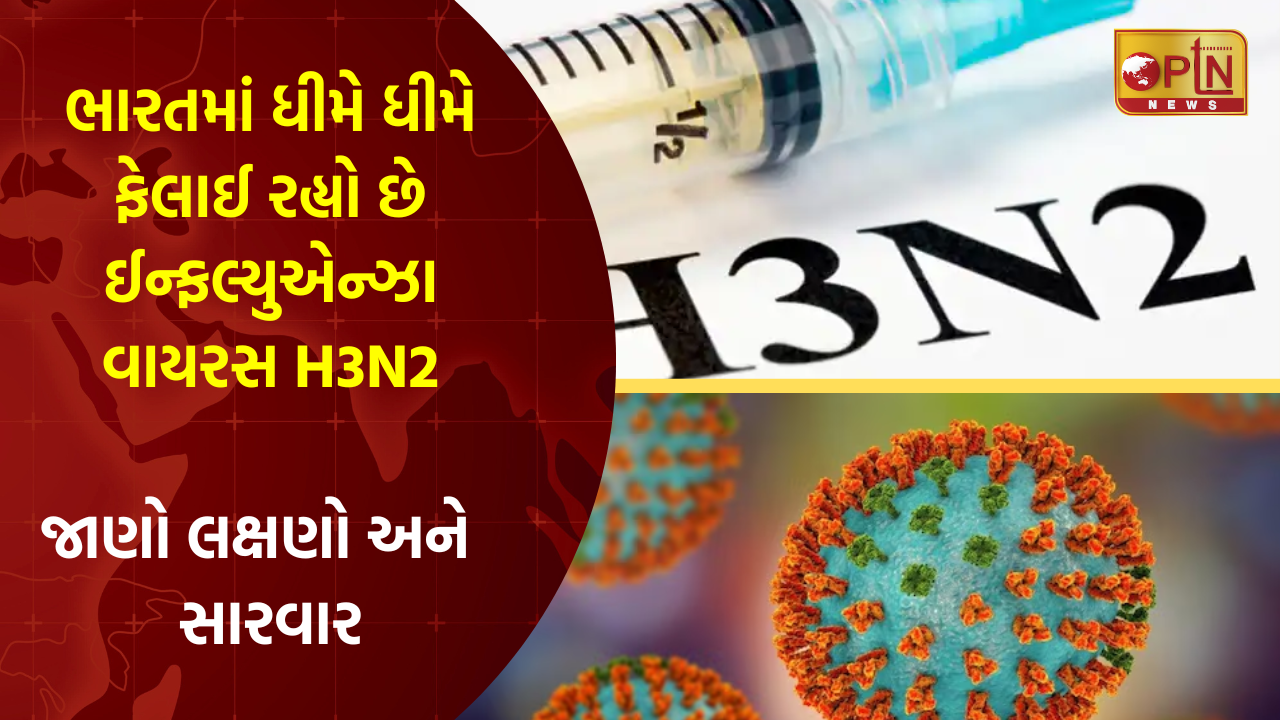As India reported the first two H3N2 influenza deaths in Haryana and Karnataka amid the outbreak of seasonal influenza, the health ministry issued a statement assuring that the situation is being closely monitored on a real-time basis. The health ministry said a total of 3,038 laboratory-confirmed cases of various subtypes of influenza including H3N2 have been reported in India till March 9 including 1,245 cases in January, 1,307 in February and 486 in March.
ઈન્ફલ્યુએન્ઝા વાયરસ H3N2 ભારતમાં તેનો પ્રકોપ બતાવવાનું શરૂ કર્યું છે. વાયરસના કારણે બે લોકોના મોત થયા છે. હરિયાણા અને કર્ણાટકમાં એક-એક વ્યક્તિએ જીવ ગુમાવ્યો છે. અહેવાલો અનુસાર, કર્ણાટકના હાસનમાં એક 82 વર્ષીય વ્યક્તિ દેશમાં H3N2 થી મૃત્યુ પામનાર પ્રથમ વ્યક્તિ છે. આરોગ્ય અધિકારીઓના જણાવ્યા અનુસાર, રેન્ટ ગૌડાને 24 ફેબ્રુઆરીએ હોસ્પિટલમાં દાખલ કરવામાં આવ્યા હતા અને 1 માર્ચના રોજ તેમનું અવસાન થયું હતું. કહેવામાં આવી રહ્યું છે કે તેમને ડાયાબિટીસ અને હાઈ બ્લડ પ્રેશરની સમસ્યા પણ હતી. સ્વાસ્થ્ય મંત્રાલયના કહેવા મુજબ, દેશમાં માર્ચ એન્ડથી આ વાયરસનો પ્રકોપ ઓછો થવા લાગશે અને તેના પર સતત દેખરેખ રાખવામાં આવી રહી છે.
દેશમાં H3N2 વાયરસના લગભગ 90 કેસ નોંધાયા છે. H1N1 વાયરસના આઠ કેસ પણ નોંધાયા છે. છેલ્લા કેટલાક મહિનામાં દેશમાં ફ્લૂના કેસ વધી રહ્યા છે. મોટાભાગના ચેપ H3N2 વાયરસના કારણે થયા છે, જેને ‘હોંગ કોંગ ફ્લૂ’ તરીકે પણ ઓળખવામાં આવે છે. આ વાયરસ દેશના અન્ય ઈન્ફલ્યુએન્ઝા પેટા પ્રકારો કરતા વધુ શક્તિશાળી છે.
What is H3N2 virus?
It is an influenza virus that causes respiratory infection. The virus can also infect birds and mammals. In bird and other animals, it has mutated into many strains.
H3N2 is a subtype of Influenza A virus, which is an important cause of human influenza, according to Centres for Disease Control (CDC) and World health Organization (WHO).
What are the symptoms Of H3N2?
According to WHO, avian, swine and other zoonotic influenza infections in humans may cause disease ranging from mild upper respiratory infection (fever and cough) to rapid progression to severe pneumonia, acute respiratory distress syndrome, shock and even death. Some of the common symptoms of H3N2 virus are:
- Chills
- Coughing
- Fever
- Nausea
- Vomiting
- Throat ache/sore throat
- An ache in muscles and body
- In some cases, diarrhoea
- Sneezing and runny nose
If a person experiences difficulty in breathing, pain or discomfort in chest, continuous fever and pain in throat while gulping down the food, it is very important to see a doctor.
How does the H3N2 virus spread?
The extremely contagious H3N2 influenza can be transmitted from one person to another through droplets released when coughing, sneezing, or talking by an infected individual. It can also spread if someone touches their mouth or nose after contacting a surface that has the virus on it. Pregnant women, young children, elderly adults, and persons with underlying medical issues are at a higher risk of flu-related complications.
નિષ્ણાતોના મતે, બંને વાયરસ ખૂબ જ ચેપી છે અને તે ખાંસી, છીંક અને ચેપગ્રસ્ત વ્યક્તિના નજીકના સંપર્ક દ્વારા ફેલાય છે. ડોક્ટરોએ નિયમિત હાથ ધોવા અને માસ્ક પહેરવાની સલાહ આપી છે. ઇન્ડિયન કાઉન્સિલ ઑફ મેડિકલ રિસર્ચ (ICMR) એ નાગરિકોને છીંક અને ખાંસી વખતે મોં અને નાક ઢાંકવાનો પ્રયાસ કરવા વિનંતી કરી છે.
What are the precautions to be taken?
Since the virus attacks the respiratory tract, it is very important to:
- Keep checking the oxygen level continuously with the help of Pulse Oximeter
- If the oxygen saturation level is less than 95 per cent, a visit to the doctor is mandatory.
- If the oxygen saturation level is less than 90 per cent, then intensive care may be required.
- Experts caution against self-medication in such cases
What are the treatment options For H3N2?
Taking proper rest, drinking lots of fluids and using over-the-counter painkillers like acetaminophen or ibuprofen to lower fever are all part of the H3N2 influenza treatment regimen. If a patient has severe symptoms or is at a high risk of problems, a doctor may also recommend antiviral drugs such as oseltamivir and zanamivir.
WHO further says that in suspected and confirmed cases, neuraminidase inhibitors should be prescribed as soon as possible (ideally, within 48 hours following symptom onset) to maximize therapeutic benefits.
Dos and Don’ts
The virus can spread rapidly among humans from infected people. So, experts say it is very important to follow some protocols:
- Regularly wash your hands with water and soap
- Wear face masks and avoid crowded areas
- Avoid touching your nose and mouth
- Cover your nose and mouth properly while coughing and sneezing
- Stay hydrated and consume plenty of fluids
- In case of fever and bodyache, take paracetamol
- નિયમિતપણે હાથ ધોવા અને જાહેરમાં હાથ મિલાવવાનું અને થૂંકવાનું ટાળો.
- આંખો અને નાકને સ્પર્શ કરવાનું ટાળો.
- ખાંસી વખતે મોં અને નાકને ઢાંકવું.
- ઘરની બહાર નીકળતી વખતે માસ્ક પહેરવું જરૂરી છે.
- પ્રદૂષિત સ્થળોએ જવાનું ટાળો.
- વધુ ને વધુ પ્રવાહીનું સેવન કરો.
- શરીરમાં દુખાવો કે તાવ આવે તો પેરાસીટામોલ લો.
They also say it’s better to avoid:
- Spitting in public areas
- Using contact-based greetings such as shaking hands
- Self-medicating and taking antibiotics or any other medications without consulting a doctor
- Eating while seated next to other people

